Galaxy Z Fold 7 vs Pixel 10 Pro Fold: There's a clear winner
We may earn a commission if you make a purchase from the links on this page.

Intro
After two months of being announced-but-unreleased, the Google Pixel 10 Pro Fold has finally hit the shelves. The latest foldable phone brought the first 3nm Tensor chipset, an IP68 water and dust resistance that's a first on foldable phones, and fresh new AI features.
As it's the only serious rival to the Galaxy Z Fold 7 that is officially on sale in the US, many may be asking as to how it stacks up against Samsung's wildly popular foldable phone.
To find out whether one is better than the other, we ran both phones through our in-house tests for battery life, camera quality, display properties, and raw speed. Aside from that, we also spent a good chunk of time with both devices to see how these two perform in real life.
In this detailed comparison, we will share our findings and answer whether the Pixel 10 Pro Fold is a better phone than the Galaxy Z Fold 7, or if it's the other way around.
Galaxy Z Fold 7 vs Google Pixel 10 Pro Fold differences:
| Galaxy Z Fold 7 | Pixel 10 Pro Fold |
|---|---|
| Design | |
| 8.9mm thin (4.2mm when unfolded), quite light at just 215 gr | Design similar to the Pixel 9 Pro Fold |
| Slimmer and lighter (8.9 mm, 215 gr) | Significantly thicker and heavier (10.8 mm, 258 gr) |
| IP48 rating | Sturdier IP68 water and dust resistnance |
| Display | |
| 6.5-inch cover and 8-inch internal screens | A 6.4-inch cover and 8-inch internal screens |
| 2,600 nits of peak brightness | 3,000 nits of peak brightness on both displays |
| Camera | |
| Triple rear camera (200MP+12+10MP), 10MP external and 10MP internal selfie cameras | Triple rear camera (48MP+10.5MP+10.8MP), dual 10MP selfie cameras |
| Performance and memory | |
| Snapdragon 8 Elite (3nm) | Google Tensor G5 (3nm) |
| 12GB RAM with 256/512GB versions, 16GB RAM with 1TB option | 16GB of RAM; 256GB, 512GB, 1TB versions |
| Battery and charging | |
| 4,400mAh battery | 5,015 mAh battery |
| 25W wired and 15W wireless charging expected | 30W wired and 15W wireless charging |
| No magnetic attachment system | Pixelsnap |
| Price | |
| Higher $1,999 price | Unchanged starting price tag of $1,799 |
Table of Contents:
Read more:
Design and Size
Significant changes for Samsung. What about the Pixel?
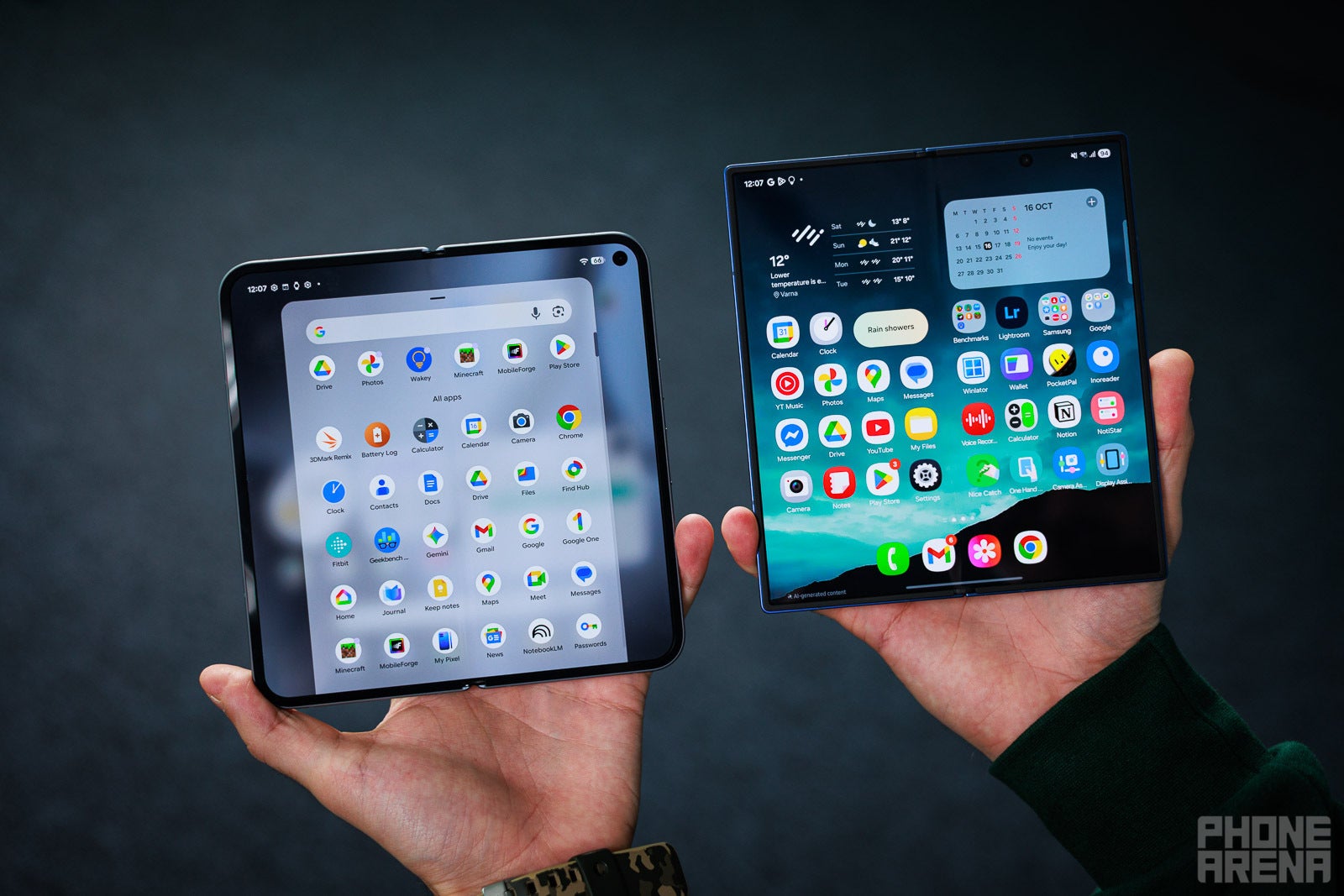
Samsung has introduced a ton of design changes with the Galaxy Z Fold 7. We get a significantly thinner book-style foldable with zero panel gap, fully clad in super-premium materials and styled after Samsung's latest Galaxies.
We get tougher materials all around: Gorilla Glass Victus 2 at the rear and Gorilla Glass Ceramic on the cover screen, while the frame is made of Advanced Armor Aluminum. The phone is IP48-rated, which gives it some protection against dust particles larger than 1 mm, but does not make it completely dust-proof.
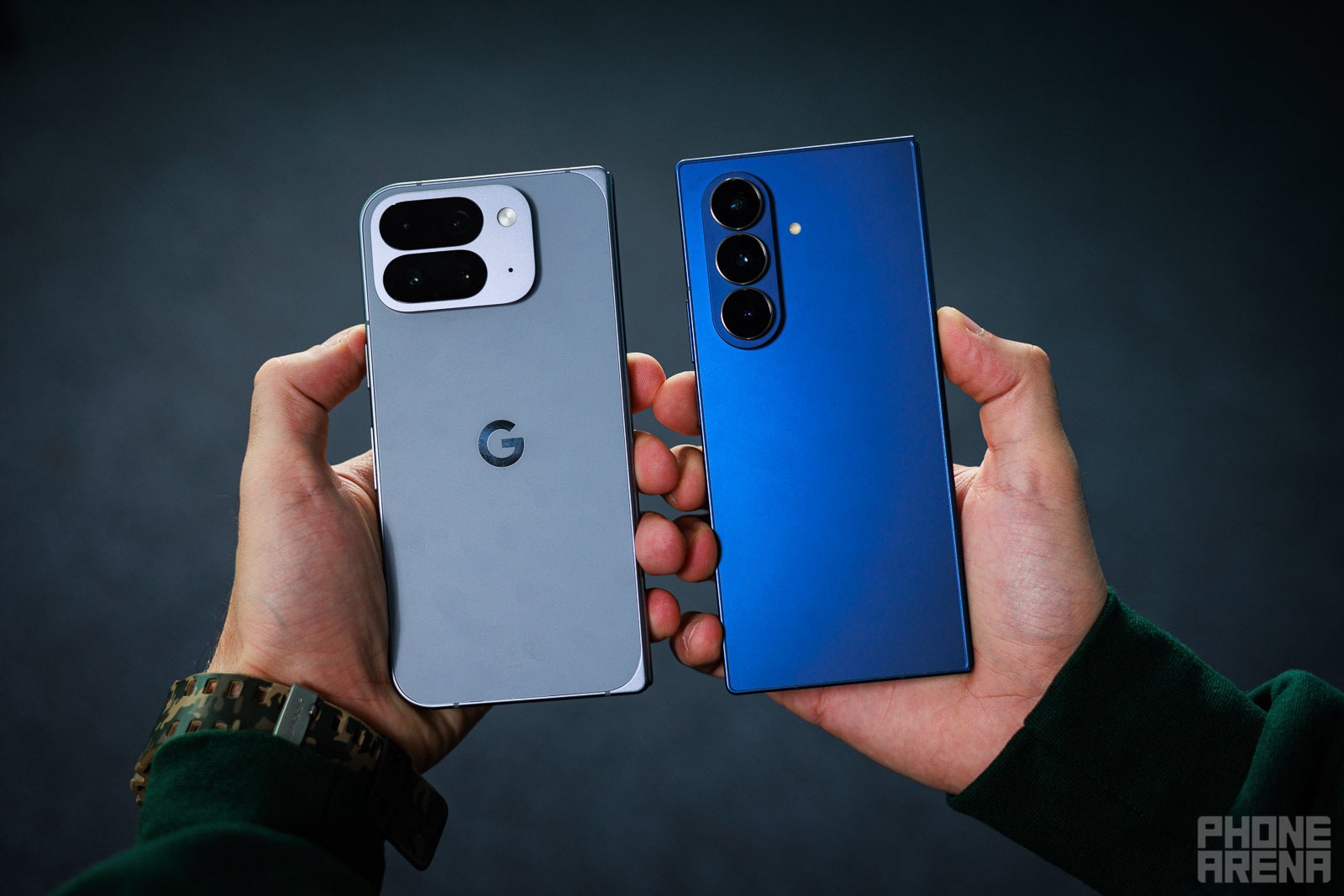
Oh, and Samsung has finally addressed the display crease seriously: there's a titanium lattice beneath the screen, with 50% tougher ultra-thin glass protecting the display, greatly reducing the crease and finally catching up with the competition. The main screen is now adorned with a punch-hole, as the under-display selfie is finally gone.
The thickness, or the lack of it, is definitely the highlight here. While it's technically not the thinnest foldable in the world (it's tied with the Oppo Find N5), the Galaxy Z Fold 7 is exceptionally thin at just 8.9 mm folded and 4.2 mm when unfolded. Easily the thinnest foldable phone you'll be able to get officially in the US in the foreseeable future.
Meanwhile, the Pixel 10 Pro Fold kept the same design language as the Pixel 9 Pro Fold, with little to no changes at all aside from the available colors. This foldable is actually thicker at 10.8 mm folded and 5.2 mm unfolded.
Google's third foldable phone is also one gram heavier at 258 gr, a far cry from the super-light 215 gr Samsung phone. Tipping the scales at just 215 gr, the phone is lighter than, say, a Galaxy S25 Ultra, making it the lightest foldable we've seen, an exceptional achievement.
Overall, it's a definite win for the Samsung foldable, which is on a whole different level than the Pixel.
| Galaxy Z Fold 7 | Pixel 10 Pro Fold |
|---|---|
| Dimensions 158.4 x 143.2 mm | Dimensions 155.2 x 76.3 mm |
| Thickness 4.2 mm unfolded 8.9 mm folded | Thickness 5.2 mm unfolded 10.8 mm folded |
| Weight 215 gr | Weight ~258 gr |
One thing that separates the Pixel 10 Pro Fold and the Galaxy Z Fold 7 is the water and dust resistance. The Google foldable is an IP68-rated device, a first on a foldable phone and on par with most regular flagship devices out there. With foldables in particular, dust resistance is crucial, as it ensures no dust will be able to enter the hinge mechanism and hurt it in any way.
The Galaxy Z Fold 7 only boasts an IP48 water and dust resistance, which doesn't protect against dust.
Display Differences

Both feature excellent displays (Image by PhoneArena)
The Galaxy Z Fold 7 arrives with a slightly larger 6.5-inch Dynamic AMOLED 2X cover screen, which now boasts a more sensible 21:9 aspect ratio. That's a great move in comparison with the narrower 22.1:9 screen on most previous Folds. This makes the Galaxy Z Fold 7 more suited for regular everyday use.
As a result of the aspect ratio reshuffle, the inner screen has also grown to 8 inches in size, a pretty sizeable change in comparison with the 7.6-inch internal screens of most previous Fold phones.
Aside from that, the core specs of the Galaxy Z Fold displays are mostly similar. This means dual Dynamic AMOLED 2X panels with a smooth 1-120Hz refresh rate, excellent sharpness, and a peak brightness of 2,600 nits on both panels. We love that.
| Galaxy Z Fold 7 | Pixel 10 Pro Fold |
|---|---|
| Cover screen 6.5 inches | Cover screen 6.4 inches |
| Main screen 8.0 inches | Main screen 8.0 inches |
In the other camp, the Pixel 10 Pro Fold has scored a 6.4-inch outer screen with a higher 3,000 nits of brightness. The internal screen is an 8-inch one, and it has also got the 3,000-nit peak brightness upgrade. Both displays will be OLED ones, of course, with up to a 120 Hz refresh rate.
Sadly, the Pixel still has the unsightly crease that most other foldables, the Galaxy Z Fold 7 included, have already fixed.
In our in-house display tests, the Pixel 10 Pro Fold achieves a slightly higher peak brightness, but the Galaxy Z Fold 7 isn't too far behind. The minimum brightness on the Samsung phone is also superior. The out-of-the-box color accuracy is also won by Samsung, which has slightly better-calibrated inner and outer screens.
Both phones feature capacitive fingerprint scanners positioned on the side-positioned power button of either phone. The biometrics are a bit better on the Galaxy Z Fold 7, as it functions a bit faster and is slightly more reliable in comparison.
Also read:
Performance and Software
One crushes the benchmarks, the other definitely not

The Samsung is the better performer by a long shot (Image by PhoneArena)
The Galaxy Z Fold 7 comes with the Snapdragon 8 Elite chipset, the first Qualcomm chip built on a 3nm manufacturing node. As usual with Samsung, it's a slightly tuned-up version of the Snapdragon 8 Elite, which carries a higher clock speed along with the "for Galaxy" suffix.
Samsung phones equipped with this chip are proper powerhouses that are among the better-performing ones on the market right now, so we are certain that from a pure performance perspective, the Z Fold 7 will be the superior device.
The Pixel 10 Pro Fold comes equipped with the Tensor G5 chip, built by TSMC on a 3nm manufacturing node. That's similar to the Snapdragon 8 Elite, but we doubt that the Tensor would be able to match the Snapdragon in terms of raw power.
The Pixel 10 Pro Fold comes equipped with the Tensor G5 chip, built by TSMC on a 3nm manufacturing node. That's similar to the Snapdragon 8 Elite, but we doubt that the Tensor would be able to match the Snapdragon in terms of raw power.
In our synthetic benchmarks, the Galaxy Z Fold 7 totally beats the Pixel 10 Pro Fold in the Geekbench single- and multi-core tests. The spread is especially striking in the multi-core test, where the Snapdragon chip commands a solid lead over the Tensor G5 chip.
The difference in graphics performance is similar: the Snapdragon simply rules the roost once again, with the Tensor way behind in both peak and sustained graphics performance.
In terms of memory, the Galaxy features 12GB of RAM with the 256 and 512GB versions and 16GB with the 1TB one, while the Pixel packs 16GB of memory in all of its three storage versions (256GB, 512GB, and 1TB). This should give some decent legroom for on-device AI and multitasking.
The Galaxy Z Fold comes along with Android 16 and One UI 8 (the first Samsung device to do so), while the Pixel 10 Pro Fold arrives with Android 16 out of the box as well.
In terms of new features, the Galaxy Z Fold 7 brings the best of Gemini, Circle to Search, as well as key improvements to Galaxy AI. The latter scores a so-called AI Results View, which displays results from AI searches in a separate split-view tab or in a floating window, thus not obstructing your original content.
The Pixel 10 Pro Fold arrives with the full suite of Gemini features. There's also the Magic Cue feature, which intelligently suggests relevant information when the need arises. Say someone texts you about a dinner reservation; Magic Cue will scan your Gmail account for reservation confirmations and display the relevant details to you.
In terms of software support, both devices will be supported for seven years starting from 2025, which means they should be kept up-to-date until 2032.
Camera
Big improvements for the Samsung foldable
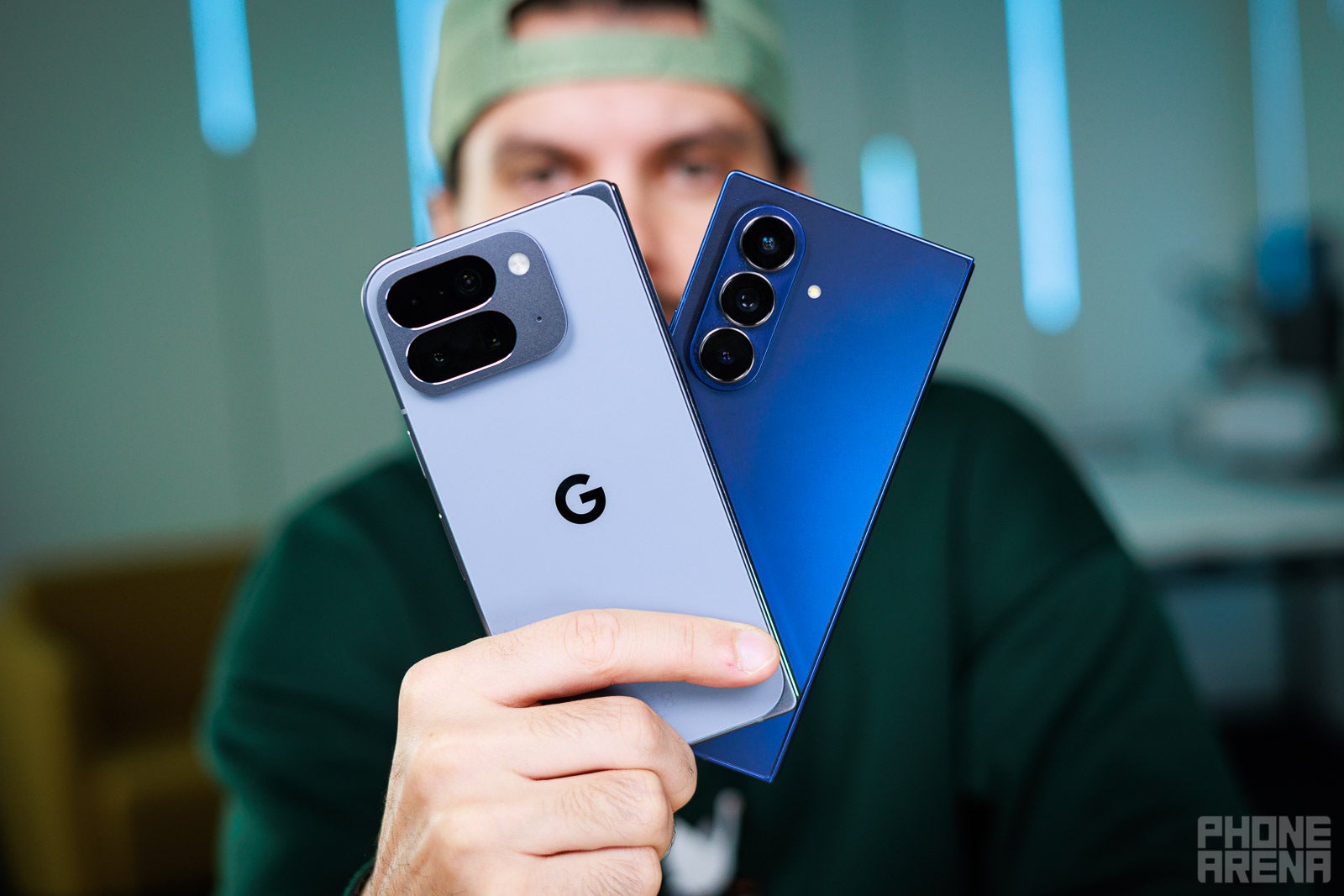
Triple cameras on both (Image by PhoneArena)
The Galaxy Z Fold 7 finally addresses one of the sore points with most previous Galaxy Z Fold devices and scores a higher-res 200MP main camera. In case you're wondering, yes, it appears to be the same one that graces the Galaxy S25 Ultra, judging by the specs alone. At long last, a camera upgrade on Samsung's most important foldable!
The rest of the cameras will be pretty familiar to anyone who has ever inspected a Galaxy Z Fold specs sheet: a 12MP ultrawide and a 10MP telephoto with 3X optical zoom. Not a particularly exciting camera setup, but then again, foldables aren't really about the camera prowess. Still, the latest foldables from Oppo, Vivo, and Honor put stronger emphasis on the camera performance.
A surprising development is the under-display selfie camera on the inner screen, which is gone! It's been substituted for a standard punch-hole 10MP camera, which is honestly the right way to go. Much more usable than the peculiar under-display one, that's for sure.
| Galaxy Z Fold 7 | Pixel 10 Pro Fold |
|---|---|
| Main camera 200MP | Main camera 48MP |
| Ultrawide 12MP | Ultrawide 10.5MP |
| Telephoto 10MP 3X | Telephoto 10.8MP 5X |
| Cover selfie 10MP | Cover selfie 10MP |
| Internal selfie 10MP under-display | Internal selfie 10MP |
The Pixel 10 Pro Fold features the same camera setup as its predecessor. It comes with a 48MP main camera, a 10.5MP ultrawide, and a 10MP telephoto with a longer 5X zoom. This setup sounds slightly more capable, and Google's software optimizations might squeeze out a better image quality out of the existing hardware. Google prides itself on the improved video stabilization, for example.
PhoneArena Camera Score:
Main camera
While both devices are very comparable in terms of dynamics and details, the color differences are the starkest. The Galaxy casts a noticeable green tint across the whole image, which isn't something the Pixel does.
Zoom Quality
The green tint with the Galaxy continues in the zoom shots as well. The Pixel is a bit more realistic here, but the Galaxy is more detailed and has a richer dynamic range, capturing a bit more detail in the clouds, for example.
Ultrawide Camera
The Galaxy carries on with the green tintage, while the Pixel 10 Pro Fold performs slightly better with a more dramatic image. However, the dynamic range is once again better with the Galaxy, as it captures significantly more information in the trees and the shrubbery in the foreground.
Selfies
Both phones take great selfies, with the Galaxy being slightly more detailed, but the Pixel 10 Pro Fold is still producing a mighty fine photo.
Battery Life and Charging
Lagging way behind other foldables
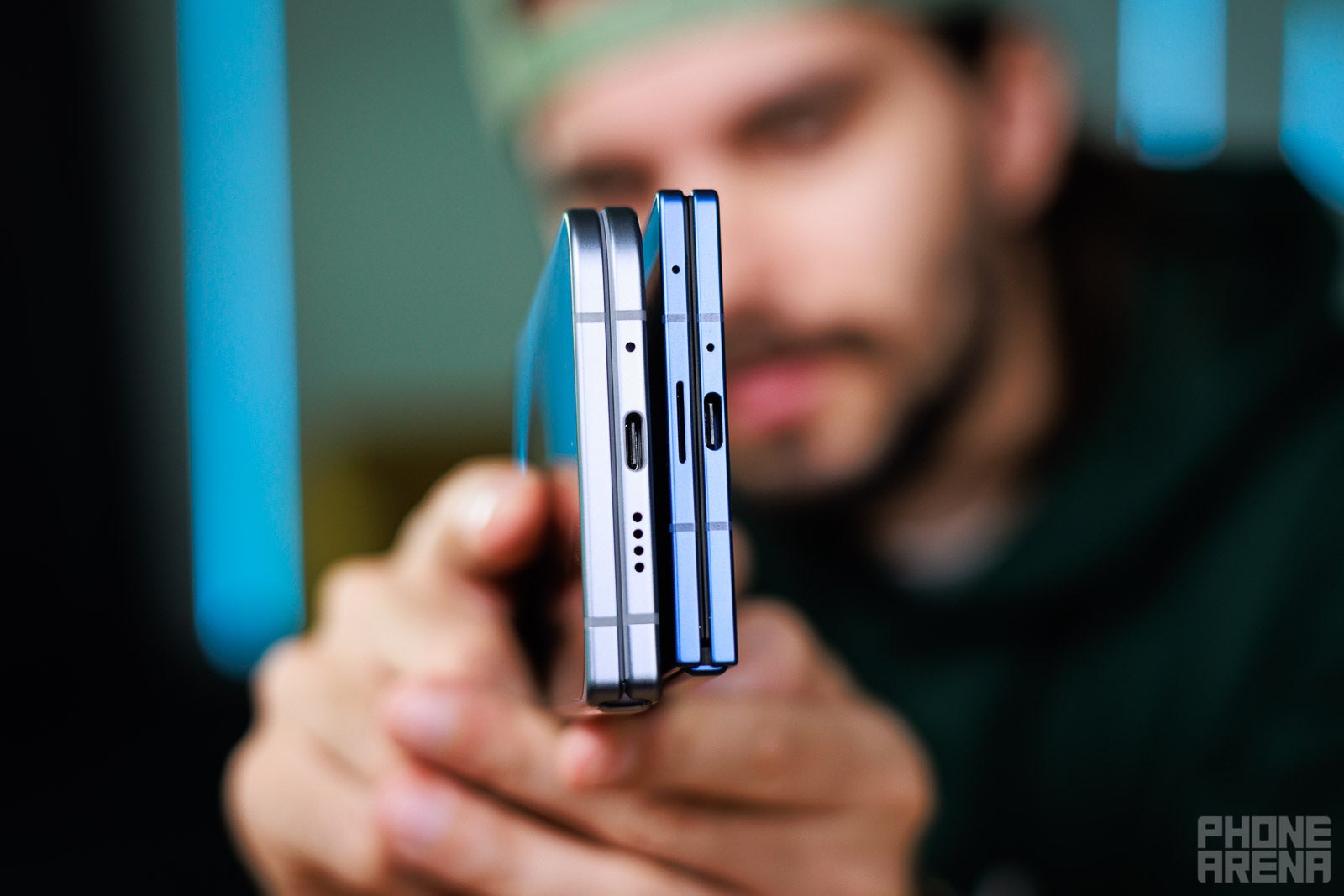
The Galaxy Z Fold 7 features a fairly lackluster 4,400 mAh battery, and the Pixel 10 Pro Fold comes with a 5,015 mAh battery, which is an improvement over the Pixel 9 Pro Fold. However, neither device can pride itself on particularly great battery life. Both devices gravitate towards the five and a half hours of battery life.
PhoneArena Battery and Charging Test Results:
The Pixel 10 Pro Fold beats the Galaxy in our web browsing test, which means it has the upper hand in regular everyday scenarios. However, the Galaxy scores a slightly better battery life in video streaming and significantly better endurance in our 3D gaming test, where the Pixel 10 Pro Fold suffers a fiasco. If gaming is important to you, get the Galaxy and forget the Pixel.
The Galaxy Z Fold 7 comes with 25W wired and 15W wireless charging, which is apparently the best Samsung could do for its $2,000 foldable. The Pixel 10 Pro Fold has scored 30W wired and 15W wireless charging with Qi2 support.
The Galaxy Z Fold 7 comes with 25W wired and 15W wireless charging, which is apparently the best Samsung could do for its $2,000 foldable. The Pixel 10 Pro Fold has scored 30W wired and 15W wireless charging with Qi2 support.
Thanks to this, the Samsung foldable charges slightly faster, in just 83 minutes. In the meantime, the Pixel takes 94 minutes for a full charge, but it charges faster in the first 30 minutes: 54% versus 46% on the Pixel.
One new feature of the Pixel 10 range is the Pixelsnap system, which features embedded magnets and allows you to magnetically attach accessories to the back of the device. Pixelsnap is compatible with MagSafe, so your iPhone accessories, phone stands, and battery banks will work with Pixelsnap. Google also has a selection of Pixelsnap accessories readily available for the Pixel 10 series.
Audio Quality and Haptics
Both phones come with stereo speakers, but it's the Pixel 10 Pro Fold that delivers the slightly more intriguing audio experience. It can get slightly louder without any distortion at higher volumes. The bass is also slightly more pronounced on the Pixel, making it a slightly better choice if you enjoy listening to music from your phone's speakers.
The haptics are great on both devices, but the ones on the Galaxy Z Fold 7 are a bit stronger. The Pixel 10 Pro Fold's are equally as precise and crisp, just not as strong. You can fine-tune the intensity on both devices.
Specs Comparison
Here's how the Galaxy Z Fold 7 vs Pixel 10 Pro Fold specs compare:
| Galaxy Z Fold 7 | Pixel 10 Pro Fold |
|---|---|
| Size, weight 158.4 x 143.2 x 4.2 mm (8,9 mm folded) 215gr IP48 | Size, weight 155.2 x 150.4 x 5.2 mm (10.8 mm folded) 258gr IP68 |
| Screen 8.0" OLED internal, 120Hz, 2600 nits 6.5" OLED external, 120Hz 2600 nits | Screen 8.0" OLED, 120Hz, 3000 nits 6.4" OLED, 120Hz, 3000 nits |
| Processor Snapdragon 8 Elite for Galaxy 3nm | Processor Tensor G5 3nm |
| Versions: 12GB/256GB 12GB/512GB 16GB/1TB LPDDR5 | Versions: 16GB/256GB 16GB/512GB 16GB/1TB LPDDR5 |
| Cameras: 200MP main 12MP ultra 10MP 3X zoom 10MP front 10MP internal front | Cameras: 48MP main 10.5MP ultra 10.8MP 5X zoom 10MP front 10MP internal front |
| Battery: 4,400 mAh | Battery: 5,015 mAh |
| Charging: USB-C 25W wired 15W wireless | Charging: USB-C 30W wired 15W wireless Pixelsnap |
Also read:
Summary
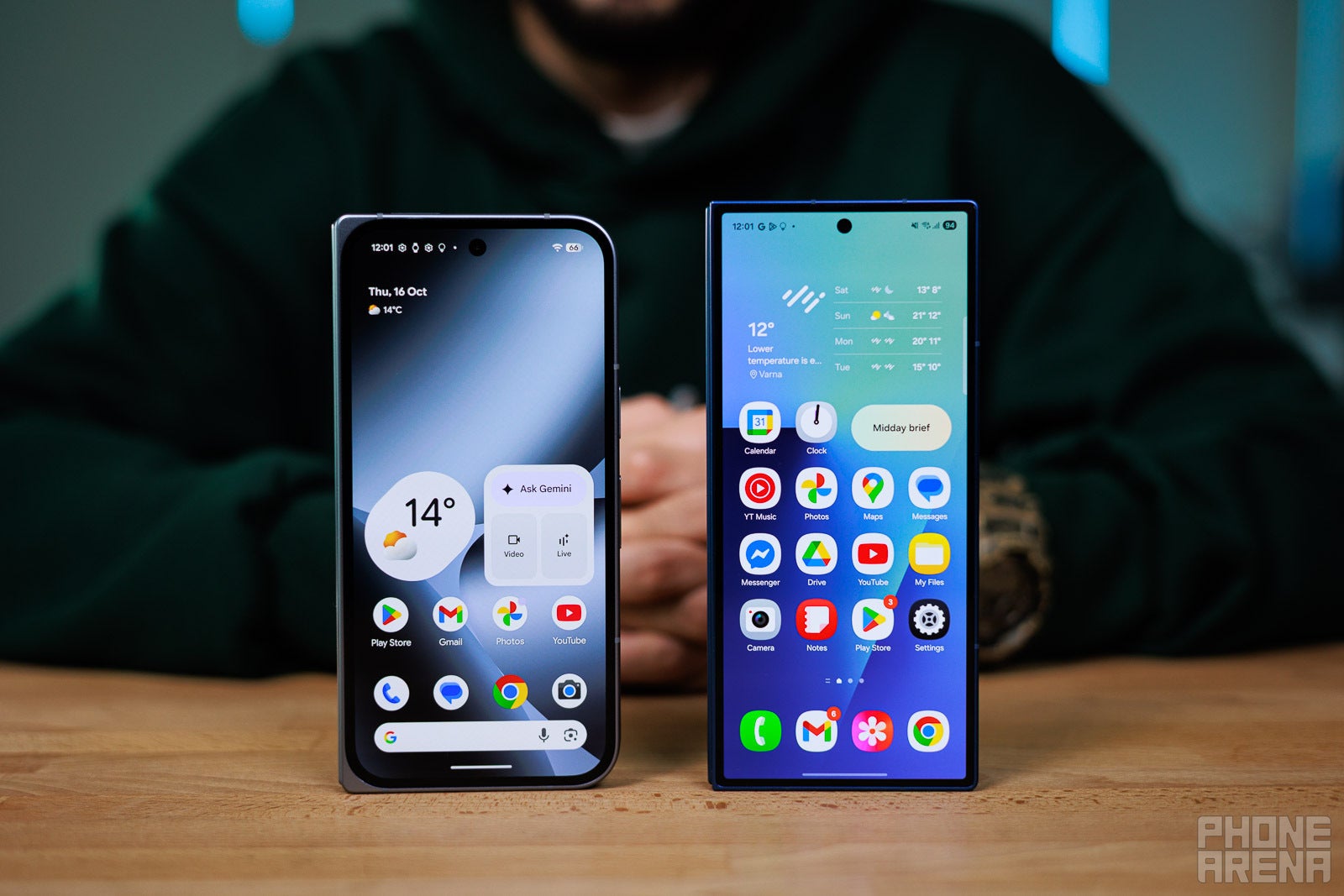
The Pixel 10 Pro Fold and the Galaxy Z Fold 7 are the two highest-profile foldable phones released in the US this year.
However, the win is almost certainly going Samsung's way, which has arguably delivered the better foldable device. Google is stuck in place with the Pixel 10 Pro Fold, which doesn't move the overall experience much forward and is barely a slight refresh of last year's Pixel 9 Pro Fold.
Although the Galaxy Z Fold 7 is the more expensive device, starting at $2,000 in comparison with the Pixel 10 Pro Fold which is technically more affordable at $1,800, it still feels that getting the Samsung foldable is the better value. It gets you a significantly better designed body, with much better performance and slightly better battery life. We also enjoy using One UI a bit more than the pure Android 16 on the Pixel.
Although the Galaxy Z Fold 7 is the more expensive device, starting at $2,000 in comparison with the Pixel 10 Pro Fold which is technically more affordable at $1,800, it still feels that getting the Samsung foldable is the better value. It gets you a significantly better designed body, with much better performance and slightly better battery life. We also enjoy using One UI a bit more than the pure Android 16 on the Pixel.
Overall, the Galaxy is the better foldable to get in late 2025. Even die-hard Pixel fans should consider getting the older Pixel 9 Pro Fold over its successor, as the upgrades are questionable.
Follow us on Google News
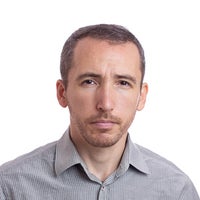
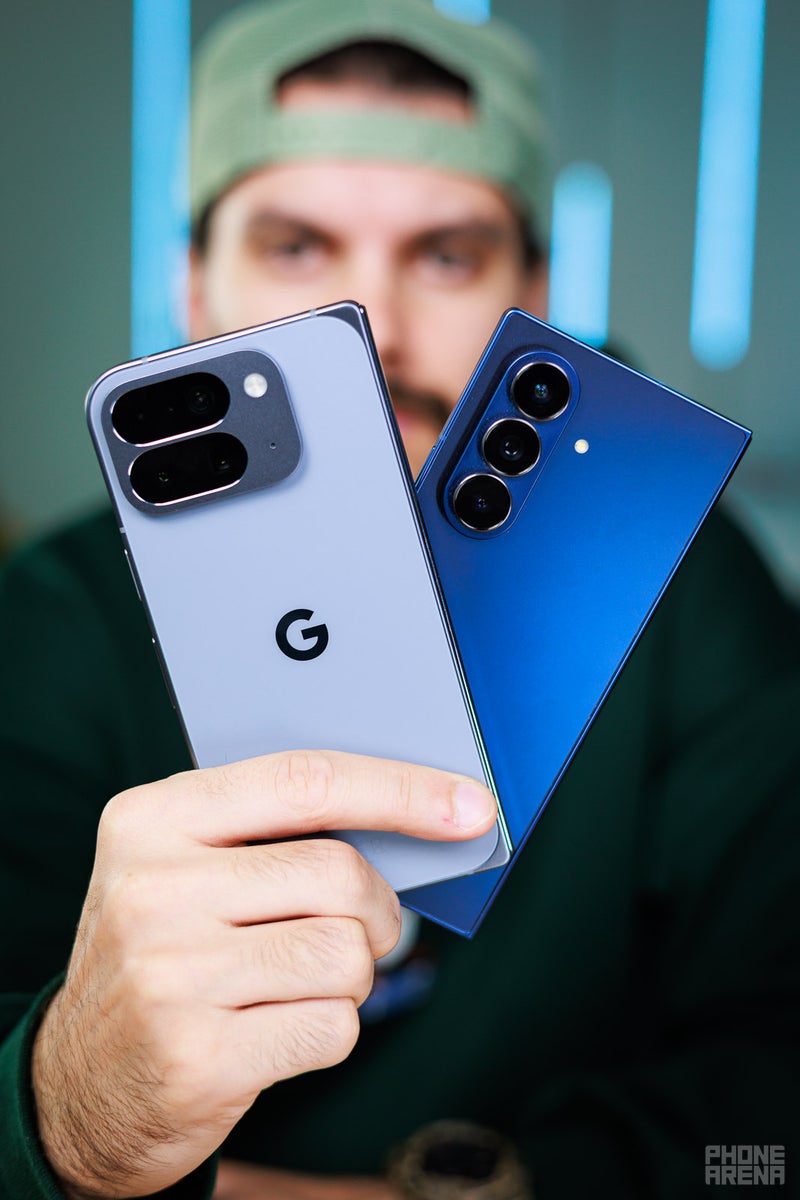











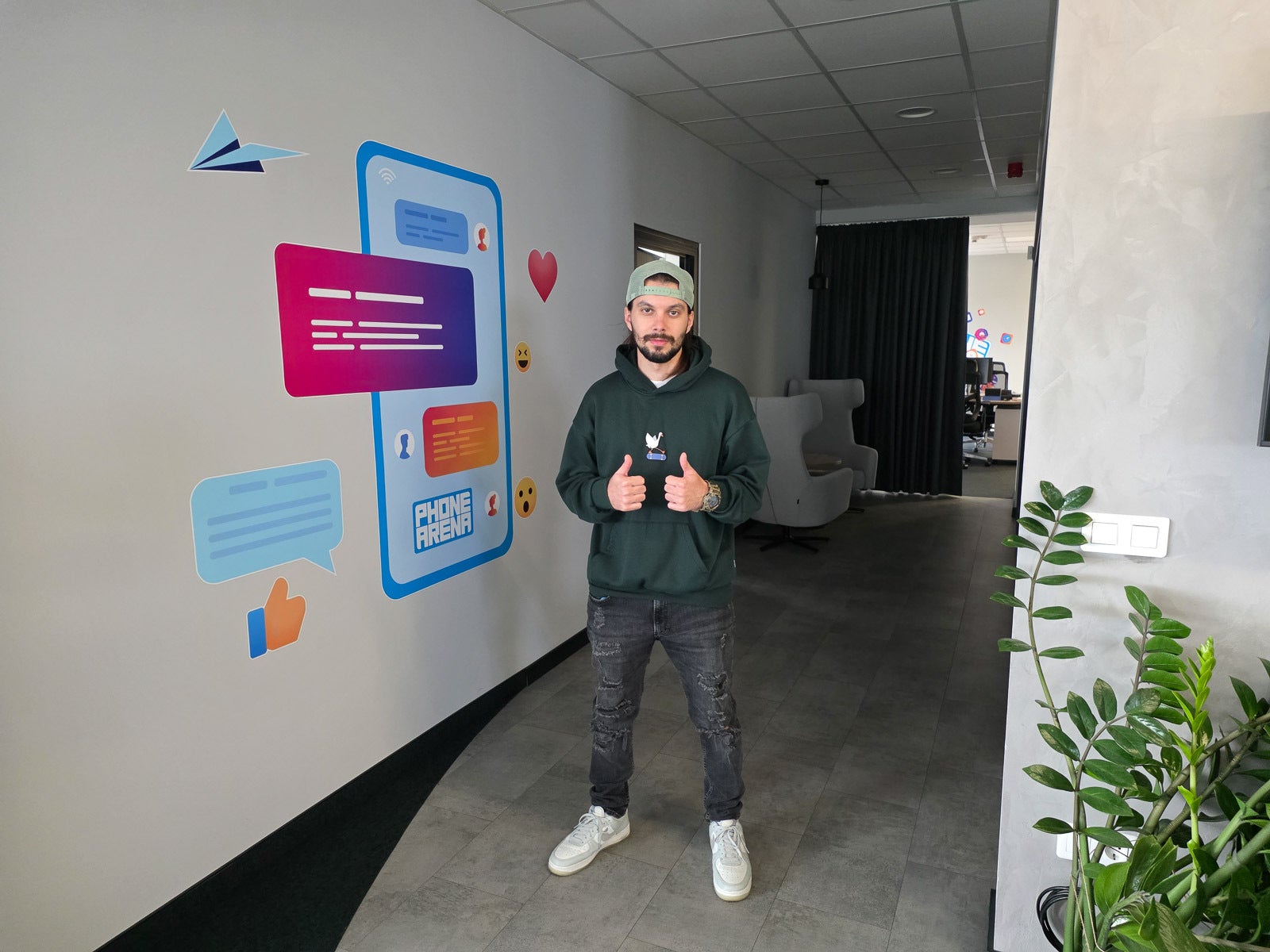

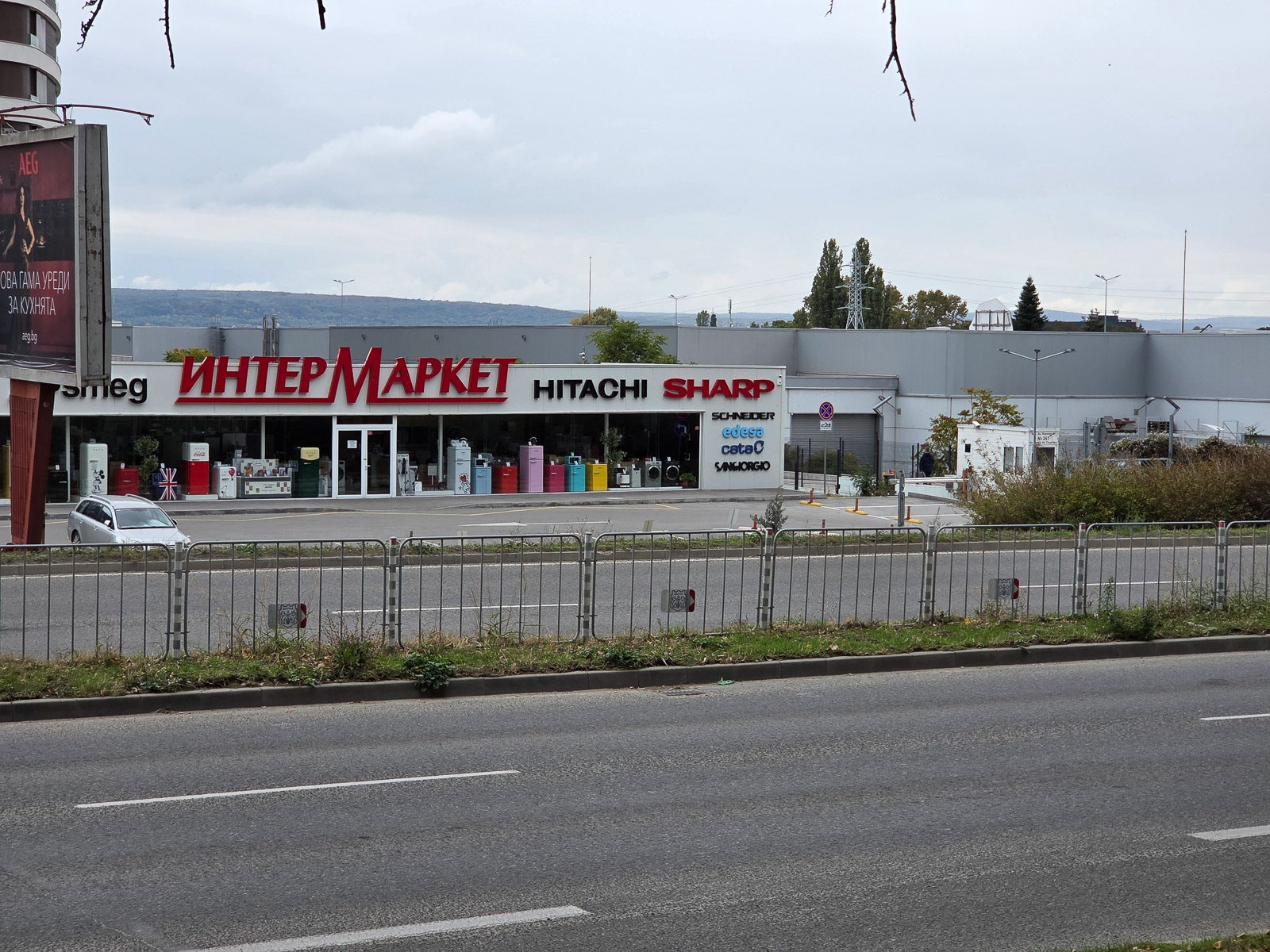




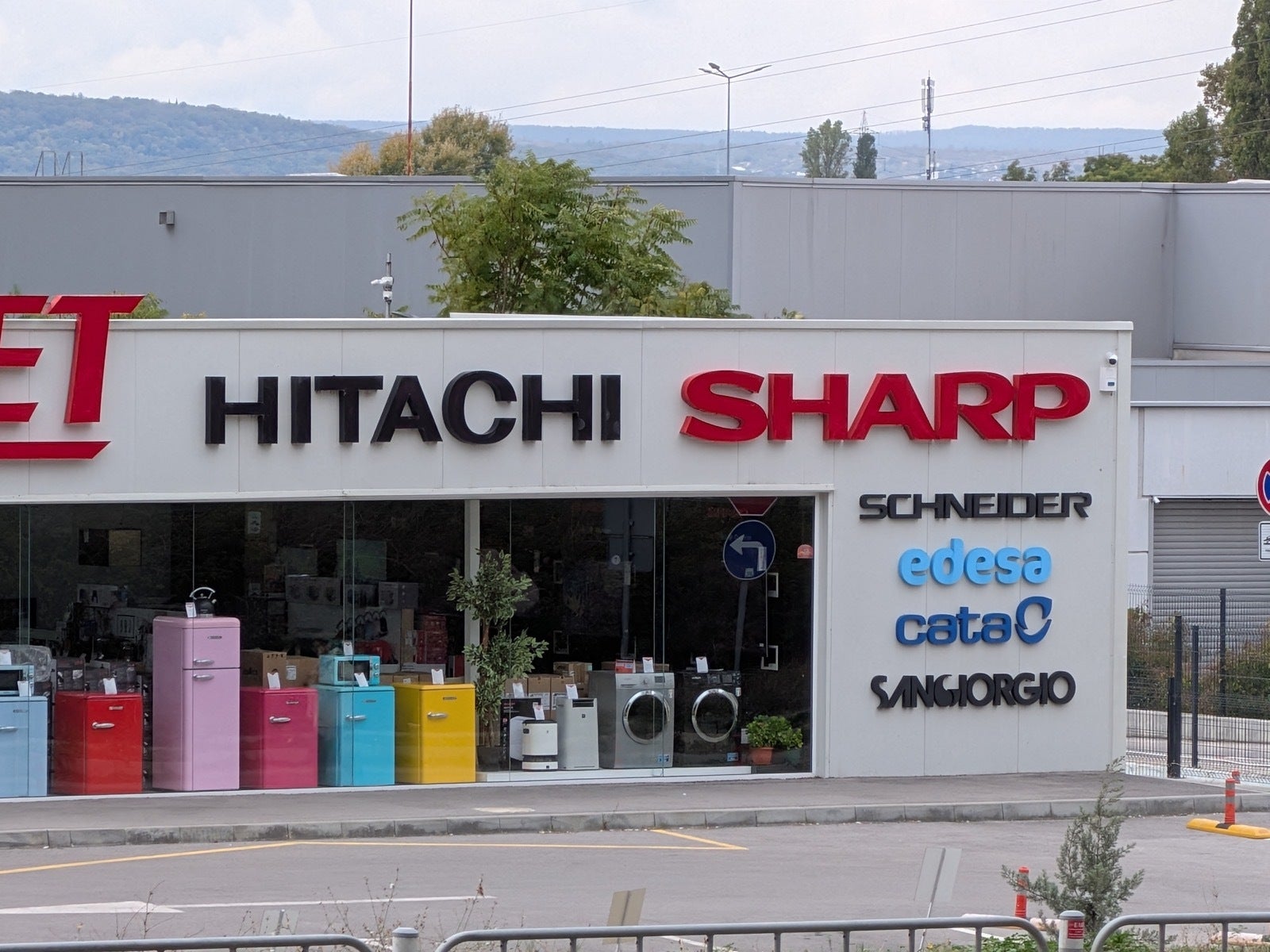
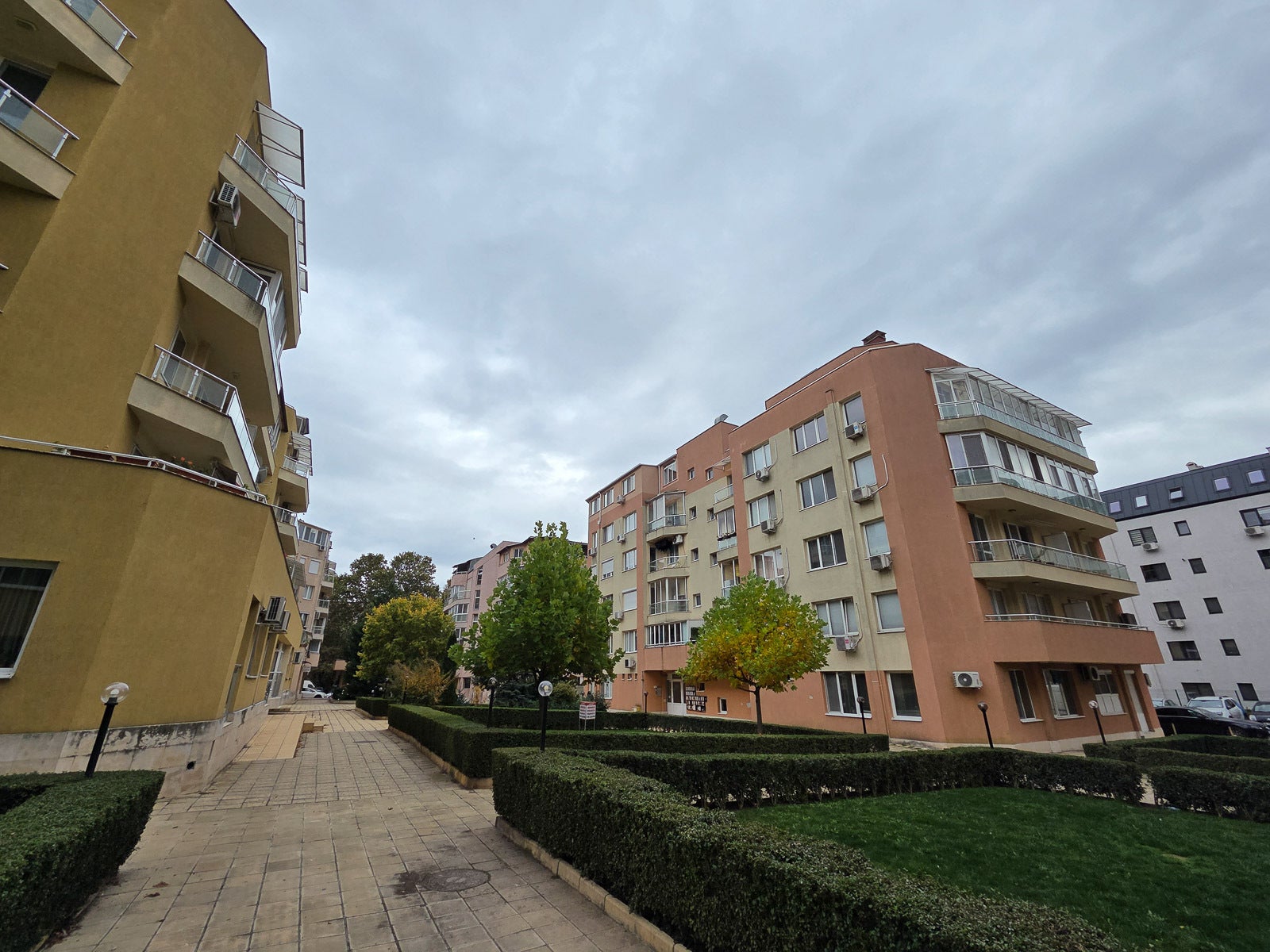
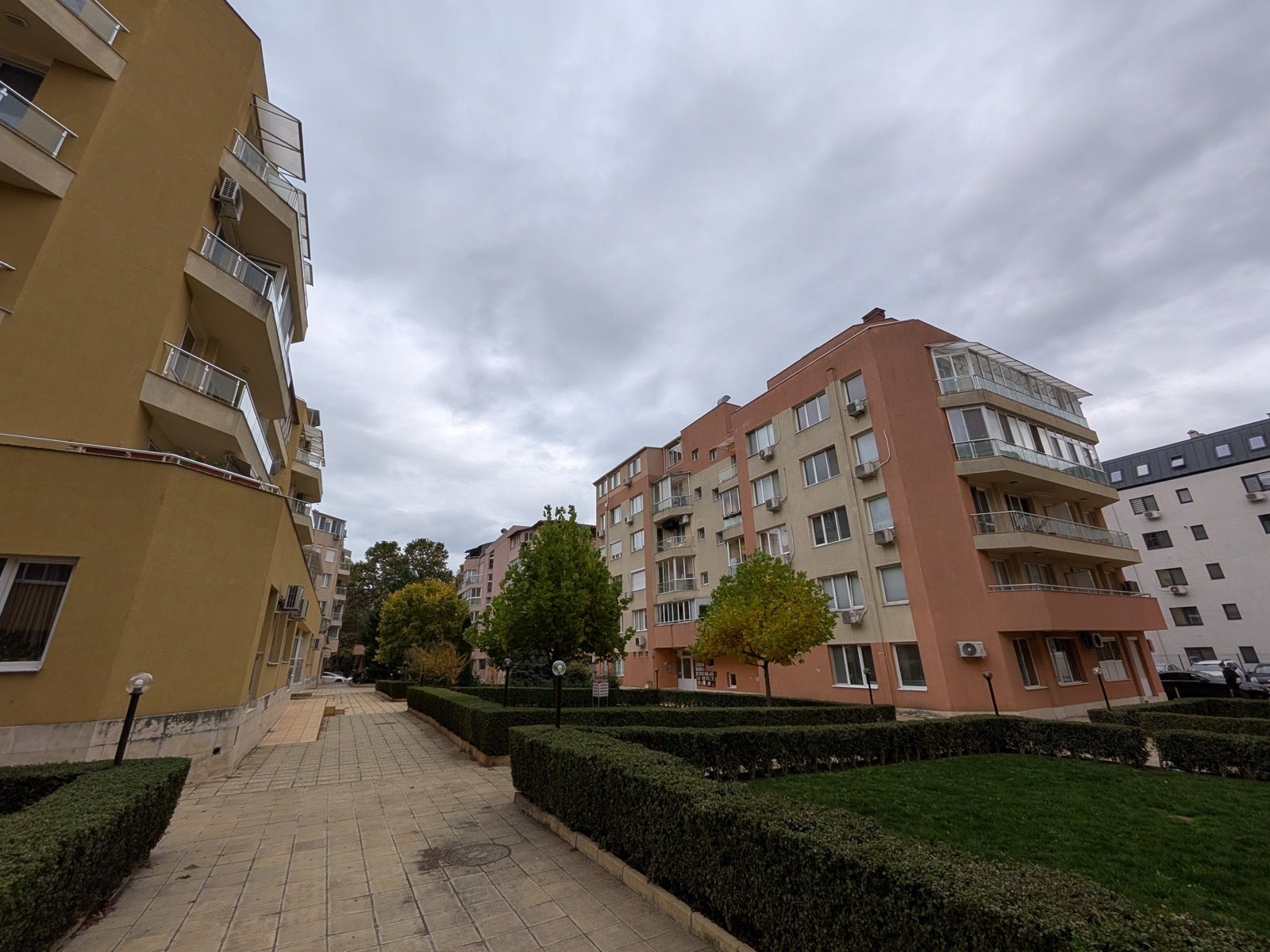
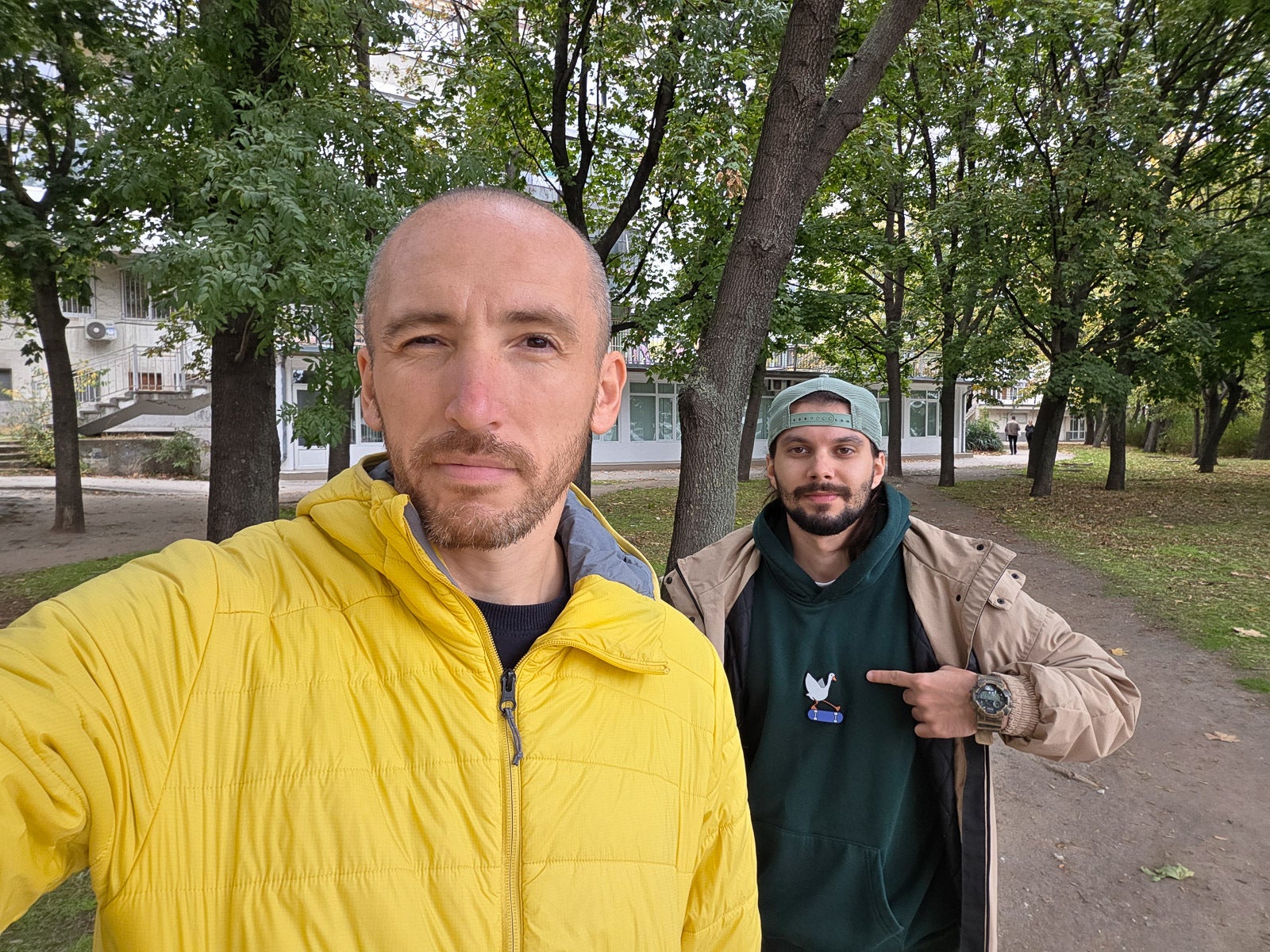
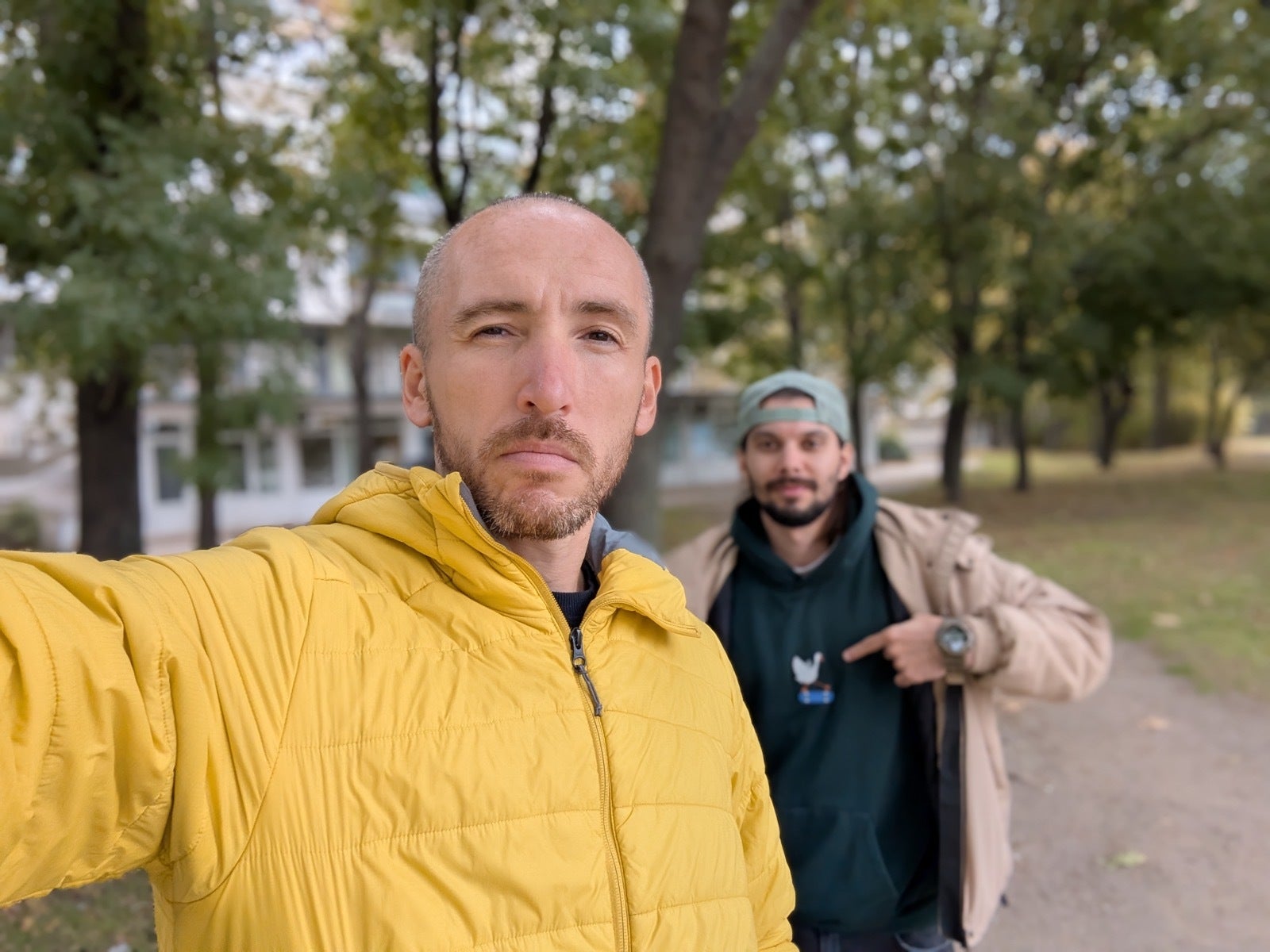












Things that are NOT allowed:
To help keep our community safe and free from spam, we apply temporary limits to newly created accounts: